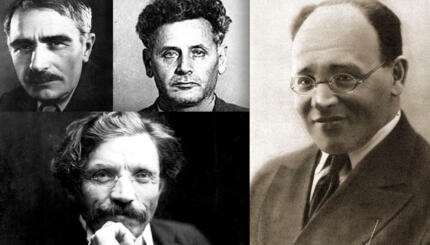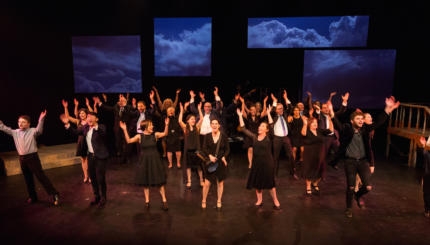The following article is adapted with permission from Reform Judaism magazine.
Jews have revolutionized American comedy. The comic books you collected, the funny movie or the sitcom you saw the other night–all have been shaped by Jewish humorists who have transformed the comedy industry since the 1950s. Jewish writers, in particular, have been the driving force in rocking the comedy boat, fueled by their “outsider” vantage point, street-smart creativity, and outsized chutzpah.
“Jew Comics” to Jewish Comedy
“With the collapse of vaudeville, new talent has no place to stink.” –George Burns
Before World War II, the Jewish presence in the comedic entertainment world was marked by humiliating self-caricature. Jews such as Jack Pearl, who played radio’s Baron Munchausen, and Al Shean of the comedy team “Gallagher and Shean” performed on the radio and in vaudeville, often wearing the accoutrements of the baggy-pants clown. 
“There were comedians called ‘Jew Comics,'” explains legendary comedian and filmmaker Carl Reiner. “They wore derbies and talked with a thick accent.” Such self-caricature was acceptable “until Hitler came along,” Reiner explains, “and then all of the Jewish accents disappeared, because we realized we were giving fodder to the enemy.”
This fear of being laughable spread to the forefront of the Borscht Belt itself, explains writer and historian
Waldoks, co-author with William Novak of The Big Book of Jewish Humor. “In 1947, there was a debate in The Contemporary Record [the magazine that preceded Commentary] between [comedians] Myron Cohen and Sam Levenson on the subject of dialects. Sam Levenson thought the Jewish dialect was demeaning, particularly after what had just happened in Europe. Myron Cohen’s retort was basically, ‘It’s only demeaning if you’re trying to demean,’ which he never did, with his use of accents.”
As apprehension over the use of accents persisted, dialect comedians such as Myron Cohen became an increasingly rare breed.
It was this fear that kept Carl Reiner and Mel Brooks from recording “The Two Thousand Year Old Man,” who had a strong Yiddish accent. For 10 years the two had been performing the act privately at friends’ houses.
Reiner and Brooks turned down numerous offers from fellow Jewish performers to make it a more permanent work. Finally, in 1960, Steve Allen, a non-Jew, convinced Reiner and Brooks to record the routine. “He offered to pay for the recording session,” Reiner remembers, “saying, ‘You guys listen to it; if you don’t like it, burn it or throw it away. But at least put it down.’ And the next thing you know, it’s up for a Grammy!”
Beyond the Borscht Belt
“Jews of my era don’t know what it would be like to be a Norman Rockwell non-Jew. We grew up feeling like outsiders. It’s the difference between being in the ballgame and sitting in the bleachers.” –Larry Gelbart
After the defeat of Nazi Germany, new avenues opened up for Jewish artists. Longtime MAD magazine writer/cartoonist Al Jaffee, for example, had been relegated to kiddie comic books before the war, but after 1945 he started to get magazine work for publications such as Trump, Humbug, and The Realist.
“Before World War II,” he explains, “10,000 Ku Klux Klanners could march down Pennsylvania Avenue in Washington with impunity. Banks didn’t hire Jews, and hotels would post ‘Restricted’ signs, which meant ‘No Jews Need Apply.’ Suddenly, the peacetime economy kicked in. Jews were running into much less discrimination. That’s when Jews started to break away and get into advertising, radio, and early television.”
In the late ’40s, Jewish road comedians were an obscure breed; with the advent of television, they could became instant celebrities. But performing in virtually every American household forced them to adapt their acts for a more “mainstream” audience.
“Borscht Belt humor in the Catskill Mountains resorts of New York had been a more regional kind of comedy,” explains Waldoks. “Post-WWII, it became ‘de-Jew-ified,’ or ‘Pareve-ised,’ to reach out to a larger audience. From a sociological point of view, in many ways this shift represents the beginning of America becoming more Jewish and Jews becoming less Jewish.”
A scene from Admiral Broadway Review, with Sid Caesar and Imogene Coca
The Sid Caesar Legacy
Brad Darrach: “Is it true that everybody hated you on Your Show of Shows?”
Mel Brooks: “Everybody hated everybody. We robbed from the rich and kept everything.”
–Playboy interview, 1975
Meanwhile, a versatile young musician-turned-comic named Sid Caesar was starring in a series of ambitious revues in Pennsylvania’s Pocono Mountains produced by the brilliant comedy impresario Max Liebman. In 1949, Caesar and Liebman were tapped by NBC to adapt their show for television. The result, the Admiral Broadway Review, starring Sid Caesar and Imogene Coca, ran for only 19 weeks–but from its demise emerged Your Show of Shows.
Bolstered by a powerhouse group of writers (including Mel Brooks and Neil Simon) who will go down in history as the Round Table to Caesar’s King Arthur, Your Show of Shows featured everything from sly social commentary to parodies of highbrow culture, such as opera and foreign art films. It remains the standard by which all other sketch comedy shows are measured.
While Your Show of Shows never directly addressed Jewish issues or topics (very few television shows did at the time), the sketches often contained Jewish references. “Caesar did a Japanese character named ‘Taka Meshuga,'” Waldoks says, “which in Yiddish means ‘Really Crazy.’ Of course people in Iowa had no idea what Taka Meshuga meant. It sounds Japanese. So it was a wink, a way of coming out every week and saying, ‘We know you’re out there. And we’re here.'”
Your Show of Shows was replaced in 1954 by Caesar’s Hour, and Larry Gelbart (later known for the TV series M*A*S*H and the film Tootsie) joined the writing team. The Jewish background of most of the writers had a significant influence on the show, Gelbart says. “Whatever makes us what we are, that’s what worked its way in–that sense of irony, a sense of caustic wit, of defensive wit, offensive wit, all the tools that 3,000 years of getting kicked in the yarmulke will instill in you.”

Help us keep Jewish knowledge accessible to millions of people around the world.
Your donation to My Jewish Learning fuels endless journeys of Jewish discovery. With your help, My Jewish Learning can continue to provide nonstop opportunities for learning, connection and growth.
Magazine MADness & the New Comedy
The mold for the modern American humor magazine was cast in downtown Manhattan. MAD made its debut in 1952 as a comic book (it became a magazine in 1955 to avoid censorship) founded by Jewish “red diaper baby” Harvey Kurtzman, an eccentric iconoclast who inspired fierce loyalty among his admirers.
From the start, says longtime MAD contributor and New Yorker cartoonist Paul Peter Porges, MAD had its roots in a proud tradition of Jewish American comedy. “When you analyze it, Jewish humor in America is distinct for one simple reason: it’s urban. And urban immediately means smart-ass.”
MAD’s satirical irreverence proved to be an immediate hit among children and young teens, much to their parents’ dismay. This pulpy 10-cent comic magazine influenced an entire generation of burgeoning hipsters and future hippies who didn’t yet have a counterculture to call their own. “Remember,” says Porges, “this was the period of McCarthy hearings, the Cold War; those kids were Leave It To Beaver kind of people. And that’s the first time they really knew that parents, teachers, people lie. MAD parodied advertisements, commercials, and told you that you were being lied to. And kids loved it.”
Later in the ’50s, adults would come to love the magazine as well, not least because of contributions by Sid Caesar, Danny Kaye, Tom Lehrer, and other Jewish comedic geniuses.
Lenny Bruce
In 1953, a new magazine called Playboy opened another channel for young Jewish comics, among them Lenny Bruce, whose brash humor shocked audiences.
In one of his most famous routines, first printed in Playboy, Bruce differentiates between “Jewish and Goyish”: “In the literate sense–as literate as Yiddish can be, since it is not a formal language–‘goyish’ means ‘gentile.’ But that’s not the way I mean to use it. To me, if you live in New York or any other big city, you are Jewish. It doesn’t matter even if you’re Catholic; if you live in New York you’re Jewish. If you live in Butte, Montana, you’re going to be goyish even if you’re Jewish…. Celebrate is a goyish word. Observe is a Jewish word. Mr. and Mrs. Walsh are celebrating Christmas with Major Thomas Moreland, USAF (Ret.), while Mr. and Mrs. Bromberg observed
with Goldie and Arthur Schindler from Kiamesha, New York.”
Bruce’s brand of comedy–along with Mort Sahl, Shelley Berman, Mike Nichols, and Elaine May–took comedy to a new edge.
“It was beginning to be more than just insults about your mother-in-law,” comments Larry Gelbart. “The original comedy writers of burlesque and vaudeville and early radio tended to be street guys, first generation, invariably Jewish, who weren’t as conversant with themselves or the world around them as subsequent generations proved to be. Through education, through psychoanalysis, through becoming insiders rather than outsiders, commenting on the national scene–that’s when it happened.”
In 1958, stand-up comic and future Lenny Bruce biographer Paul Krassner created The Realist, which gained a huge following among the urban counterculture crowd. The humor magazine featured satirical essays, columns, and cartoons on topics such as McCarthyism, gays in the military, and drug addiction among Vietnam veterans.
The Realist also contained frequent contributions by two of Krassner’s more controversial friends: Lenny Bruce, who wrote scathing pieces on censorship; and antiwar activist Abbie Hoffman. FBI director J. Edgar Hoover did not take kindly to Krassner. In 1968 he organized a smear campaign against the publisher and other Jews associated with The Realist, including radicals Abbie Hoffman and Jerry Rubin, printing their likenesses on a WANTED poster decorated with swastikas. The Realist finally folded in December 2000, outlasting Hoover by decades.
This piece originally appeared as “Wizards of Wit: How Jews Revolutionized Comedy in America, Part I: 1950-1969 From Self-Caricature to Self-Confidence” in the Winter 2001 issue of Reform Judaism magazine.



